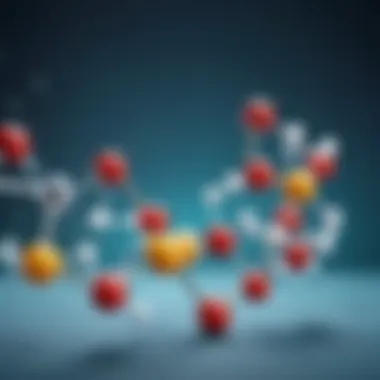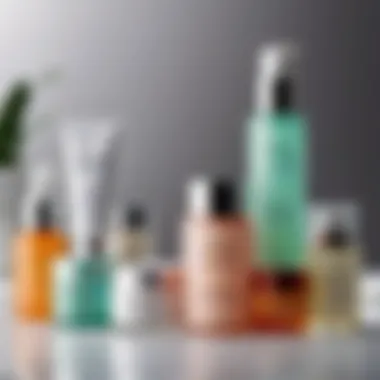Facial Peeling with AHA Acids: Deep Dive into Benefits


Intro
Chemical exfoliation has become a popular topic in skincare, particularly the use of Alpha Hydroxy Acids (AHAs) for facial peeling. These compounds, derived primarily from fruits, are known for their ability to effectively remove dead skin cells, revealing a brighter and more youthful complexion. Beyond mere aesthetics, understanding how AHA acids work is crucial for anyone looking to improve their skin health. This article will thoroughly explore the many facets of AHA-based facial peels, including their effectiveness, types, and the necessary precautions.
With a heightened awareness of personal skincare, individuals are consistently seeking to enhance their routines. AHA acids play a prominent role, especially among those who are keen to make informed choices about cosmetic treatments. The objective here is to offer a detailed guide that helps readers navigate the sometimes complex world of AHAs. Through careful investigation, we will highlight the chemical properties, application methods, and best practices for utilizing these acids to achieve optimal results.
Our discussion will also address the impact of AHA peels across various skin types, including sensitive skin. The inclusivity of this information is designed to empower all readers, both men and women of varying ages, to engage in their skincare journey responsibly and efficiently.
Understanding AHA Acids
Understanding AHA acids is fundamental to grasping how they can be effectively used for facial peeling treatments. AHAs, or Alpha Hydroxy Acids, are water-soluble acids that occur naturally in various fruits and plants. This article aims to dissect their various properties, benefits, and applications, allowing readers to make informed decisions about incorporating AHA treatments into their skincare routines. With a deeper understanding of AHAs, one can appreciate their role not only in enhancing skin texture but also in addressing specific skin concerns such as pigmentation and aging.
What are AHAs?
AHAs are organic compounds with a hydroxyl group attached to the alpha carbon. These acids are known for their exfoliating properties, which help to remove dead skin cells from the surface of the skin, promoting cell turnover. This process leads to smoother, more radiant skin. The exfoliation occurs because AHAs break down the bonds holding dead skin cells together, allowing them to slough off easily. Understanding AHAs as a category is vital, as they play a significant role in skin health.
Types of AHA Acids
Different types of AHAs have various properties and benefits. Here are some common AHAs:
Glycolic Acid
Glycolic Acid is derived from sugarcane. Its small molecule size allows it to penetrate the skin deeply, making it one of the most effective AHAs. This acid excels in improving skin texture and diminishing fine lines. Glycolic acid is often used in high concentrations in peels. Generally, it has a quick action, yielding visible results in a short time frame.
Pros: Rapid exfoliation and visible results.
Cons: Can be irritating for sensitive skin.
Lactic Acid
Lactic Acid comes from milk and is a milder alternative to Glycolic Acid. It is known for its moisturizing properties, making it suitable for individuals with drier skin. Lactic Acid not only exfoliates but also hydrates the skin, thereby improving texture without excessive irritation.
Pros: Gentle yet effective for sensitive skin.
Cons: Slower results compared to Glycolic Acid.
Citric Acid
Citric Acid is primarily derived from citrus fruits. It serves as an excellent antioxidant and has the added benefit of brightening the skin. Citric Acid can help in controlling excess oil production, making it a suitable option for oily skin types.
Pros: Brightening effects and oil control.
Cons: Can cause sensitivity in some skin types.
Malic Acid
Malic Acid is found in apples and pears. It works similarly to Glycolic Acid and Lactic Acid but has larger molecules, leading to slower penetration. Malic Acid offers gentle exfoliation while helping to maintain the skin's moisture balance. This characteristic makes it good for various skin types.
Pros: Gentle and retains skin hydration.
Cons: Less effective for prompt results.
Mechanism of Action
Understanding how AHA acids work on the skin is crucial for anyone considering facial peeling treatments. The mechanism of action outlines not only how these acids interact with skin at a cellular level but also provides insights into the benefits and potential outcomes of their use.
How AHA Acids Affect the Skin
AHA acids, or alpha hydroxy acids, are water-soluble acids derived from fruits. When applied to the skin, they penetrate the outer layer, engaging in a gentle yet effective exfoliation process. The primary effect of AHA acids is the loosening of the bonds between dead skin cells, enabling them to slough off more easily. This action enhances cell turnover, leading to a fresher and more radiant complexion.
Another significant impact of AHA acids is their ability to stimulate collagen production. Collagen is a protein that provides structure and elasticity to the skin. By promoting collagen synthesis, AHA treatments can improve skin firmness and reduce the appearance of fine lines over time. Moreover, AHA acids help to reduce hyperpigmentation, allowing for more even skin tone and texture.
"AHA acids not only exfoliate the skin but also stimulate deeper skin processes, such as collagen production."
Exfoliation Process Explained
The exfoliation process initiated by AHA acids can be divided into several stages. First, the acid penetrates the outer layer of the skin, the stratum corneum. In this layer, AHAs increase the moisture content of the skin. This action helps in the breakdown of dead skin cells and promotes the shedding of these cells.
As dead skin cells are removed, underlying layers become more visible and healthier, contributing to the overall glow of the skin. Depending on the concentration of AHA used, this process can be superficial, medium, or deep, affecting various skin types differently.
- Superficial exfoliation addresses the outermost skin layer, making it suitable for mild acne or dry skin.
- Medium peeling penetrates deeper and is generally used for more significant skin concerns like scars or hyperpigmentation.
- Deep peels reach the deeper layers of the skin, often recommended for severe sun damage or deep wrinkles.
Benefits of AHA Peeling
Facial peeling with AHA acids offers multiple benefits that are increasingly recognized in skincare regimens. Understanding these benefits can greatly help consumers make informed decisions about their skincare choices. AHA peels are known for their effectiveness in improving skin quality and promoting a healthy appearance. Four significant advantages include skin texture improvement, reduction of fine lines, enhanced radiance, and treatment of hyperpigmentation.
Skin Texture Improvement
One of the primary benefits of AHA peeling is the marked improvement in skin texture. AHA acids, particularly glycolic acid, are excellent at exfoliating the outermost layers of skin. This exfoliation process removes dead skin cells and promotes cell turnover, leading to a smoother skin surface. Over time, individuals can notice a more refined texture and a reduction in the appearance of rough patches. People with textured or uneven skin may find AHA peels especially beneficial, providing a clearer and more polished look.
Reduction of Fine Lines
Fine lines often occur due to aging and environmental factors. AHA peels can help combat this by promoting collagen production and enhancing skin elasticity. As the peel stimulates the skin's deeper layers, it encourages a more youthful appearance. Studies indicate that consistent use of AHA treatments can lead to a notable diminishment of fine lines and wrinkles, especially around the eyes and mouth. Thus, individuals seeking anti-aging solutions should consider the incorporation of AHA peels into their routines.
Enhanced Radiance
AHA peels have also been celebrated for their ability to significantly enhance skin radiance. The exfoliation process reveals fresher, healthier skin underneath, which can appear luminous and vibrant. Many users report a noticeably brighter complexion after undergoing AHA treatments. This revitalized look can be attributed to the improved circulation and revitalization of skin cells. For those aiming for a glowing appearance, AHA peels can serve as an effective solution.
Treatment of Hyperpigmentation
Hyperpigmentation, such as dark spots and uneven skin tone, is another concern that AHA peels can address. The exfoliating properties of AHA acids help diminish the visibility of these discolorations by promoting cell turnover. As the old skin fades, newer, more evenly pigmented skin is revealed. Regular treatment with AHA peels can lead to a gradual lightening of dark spots, making this method a viable option for individuals looking to correct hyperpigmentation issues.
Regular AHA peeling can be an effective strategy for improving skin quality, addressing various concerns ranging from texture to pigmentation issues.
Different Types of AHA Peels
Understanding the different types of AHA peels is vital for anyone considering facial peeling treatments. Each type serves distinct purposes and delivers varied results. When choosing an AHA peel, it is important to consider your skin type, desired outcomes, and skin sensitivity. Knowing the differences can lead to better choices, improved skin health, and a more effective treatment process.


Superficial Peels
Superficial peels, also known as light peels, primarily use glycolic acid or lactic acid at low concentrations. These peels target the outermost layer of the skin, providing minimal downtime. When performed, they result in immediate improvements in skin texture and brightness. Commonly, individuals opt for superficial peels for issues such as mild sun damage, uneven skin tone, and rough texture.
Benefits of Superficial Peels:
- Quick recovery time: Most individuals can resume normal activities right after treatment.
- Gentle exfoliation: Suitable for sensitive skin, they can be used frequently.
- Immediate results: Users often notice changes soon after the procedure.
Considerations when opting for Superficial Peels:
- Frequency: To maintain results, regular treatments may be necessary.
- Sun protection: Post-peel, skin may be more sensitive to UV exposure, necessitating sunscreen.
Medium Peels
Medium peels penetrate deeper than superficial peels, often utilizing trichloroacetic acid (TCA) or higher concentrations of AHA. These peels address more pronounced skin concerns, such as moderate sun damage, fine lines, and uneven pigmentation. The downtime typically lasts about a week as the skin undergoes the peeling process.
Benefits of Medium Peels:
- Deeper exfoliation: They can provide more significant changes in skin texture and tone.
- Stronger effect on wrinkles: They are often more effective for reducing fine lines compared to superficial peels.
- Longer-lasting results: Users might enjoy prolonged improvements from fewer sessions.
Considerations when opting for Medium Peels:
- Healing time: Expect redness and peeling for several days post-treatment.
- Consultation with a professional: Due to the stronger formulation, it is recommended to have these performed by a licensed skincare professional.
Deep Peels
Deep peels are the most intense form of AHA peeling, commonly using a high concentration of trichloroacetic acid or phenol. They dive deeper into skin layers, addressing severe skin issues such as deep wrinkles, significant sun damage, and extreme pigmentation irregularities. This type of peel requires longer recovery time, often a couple of weeks, as the skin heals significantly.
Benefits of Deep Peels:
- Dramatic results: These peels can yield profound changes, often with a single treatment.
- Long-lasting effects: While recovery is longer, many individuals see results for years afterward.
- Comprehensive skin rejuvenation: The peel can enhance the overall quality and appearance of the skin.
Considerations when opting for Deep Peels:
- Extended downtime: Patients should expect significant peeling and redness that may last up to two weeks.
- Professional supervision: Because of the intensity, deep peels must be done under the supervision of qualified dermatologists to ensure safety.
Application Techniques
Incorporating AHA acids into your skincare regime requires an understanding of application techniques. This is pivotal for optimizing results while minimizing potential side effects. Different techniques suit varying skin conditions, lifestyle, and preferences. Proper application ensures that AHA peels work effectively, delivering the intended benefits of smoother, brighter skin without heightened risks of irritation.
At-Home Peels
At-home AHA peels have gained notable popularity. They offer convenience and affordability. Many products are available, allowing individuals to tailor their routines to personal needs.
When considering at-home peels, it is essential to choose the right product. Look for formulations that are clearly labeled for home use. Key elements to focus on include:
- Concentration of AHA: Choose products with a 5% to 10% concentration for at-home use. Higher concentrations may require professional supervision.
- Instructions: Follow manufacturer instructions carefully to avoid over-exposure.
- Frequency of use: Typically, at-home peels can be used once a week. Adjust according to how your skin responds.
A patch test before applying on the face is recommended. Apply a small amount to the inner arm and observe for any adverse reaction over 24 hours.
Using at-home AHA peels can yield impressive results when done correctly, promoting a refined skin texture. However, they also require careful monitoring of the skin’s reaction throughout the process to mitigate irritation.
Clinical Treatments
Clinical AHA treatments offer stronger formulations and professional guidance. These treatments are performed in skincare clinics or dermatology offices.
The benefits of seeking clinical assistance include:
- Higher Concentration Formulations: Professionals administer peels with concentrations above 10%. This ensures more significant exfoliation but requires skilled application.
- Customized Treatment Plans: A dermatologist evaluates skin type, concerns, and goals, creating a tailored treatment plan. This approach can address issues such as pigmentation, fine lines, and overall texture.
- Post-Peel Monitoring: Professionals provide aftercare instructions and monitor the skin’s recovery. This is crucial for achieving optimal results.
During clinical treatments, multiple sessions may be recommended. The procedure generally lasts 30-60 minutes. Patients may experience some redness or tingling during application, which subsides post-treatment.
Proper application and post-peel care are critical for achieving lasting benefits from AHA treatments. Avoid sun exposure post-treatment to protect the skin.
Whether choosing at-home or clinical peels, understanding proper application techniques plays an essential role in enjoying the full benefits of AHA peeling. It allows for correction of skin issues while prioritizing safety.
Preparing for AHA Peeling
Preparing for AHA peeling is a crucial step that often gets overlooked. It encompasses various elements, including skin assessment and patch testing. Understanding these components helps in minimizing adverse reactions and better achieving the desired effects of the peel. The skin has different levels of sensitivities and needs individual care. Preparation facilitates a safe process that aligns with the unique characteristics of the skin.
Skin Assessment
A thorough skin assessment is important before an AHA peel. This step involves evaluating your skin type, condition, and history. Knowing whether you have oily, dry, or combination skin will help in customizing the treatment.
It is also crucial to consider any skin issues you might have. Conditions like eczema, psoriasis, or acne can be exacerbated by certain chemical peels. Taking note of any recent treatments or usage of products—like retinoids or prescription medications—is essential as well. Your skin’s barrier function should be intact to tolerate AHA acids effectively.
Indicators for Skin Assessment:
- Skin type (oily, dry, combination)
- Sensitive areas or skin conditions
- Recent treatments or products used
This information serves as a basis to tailor the AHA peeling process. Without a proper assessment, the risk of adverse reactions increases, which can lead to undesirable outcomes.
Patch Testing
Patch testing is a vital procedure that should not be skipped. This testing checks how your skin reacts to AHA acids before applying them on a larger area. A small sample is applied to a discreet area of skin, typically on the forearm. This method allows you to monitor any initial reactions without risking larger areas of the face.
Performing a patch test helps in identifying sensitivity or allergic reactions. If redness, itching, or blistering occurs within a few days, it indicates that AHA acids may not be suitable for your skin.
Quote:
"Forewarned is forearmed. It is better to test than to endure backlash from your skin."


How to Conduct a Patch Test:
- Apply a small amount of AHA product on a clean area of skin.
- Leave it on for the recommended time.
- Rinse and observe for 48 hours for any reactions.
This cautionary step ultimately enhances your experience with AHA peeling. Awareness of your skin’s reaction informs future usage and prevents potential side effects.
Post-Peel Care
Post-peel care is crucial for achieving the desired results after an AHA treatment. This period determines how well the skin will recover and how effective the treatment will be in the long run. Skin after peeling may be sensitive, irritated, or even red. Care during this time can significantly enhance recovery and maintain the improvements brought by the peel. Key elements involve immediate aftercare measures and a thoughtful long-term skincare routine.
Immediate Aftercare
Immediately after an AHA peel, the skin requires special attention. To mitigate potential irritation, it is advised to use a gentle cleanser. Avoid harsh scrubs or exfoliators at this stage. Instead, choose products that focus on hydration and soothing the skin. Applying an alcohol-free toner can help balance the pH levels, which may be disrupted after the treatment.
Moisturizing is vital. A rich, fragrance-free moisturizer can provide the necessary hydration and create a barrier against environmental aggressors. Look for ingredients such as hyaluronic acid and ceramides, which are known to strengthen the skin barrier. Sunscreen application is non-negotiable, as the skin will be more sensitive to UV rays post-peel.
Consider applying soothing treatments such as aloe vera gel. This can assist in calming any redness or discomfort. Additionally, it is advisable to avoid makeup for at least 24 hours following the peel, allowing the skin to breathe and recover properly.
Long-Term Skin Care Routine
Long-term skin care after an AHA peel involves integrating gentle, effective products that support skin health without over-exfoliating. Establishing a routine can help in maintaining improvements in skin texture and appearance.
- Cleansing: Continue using a mild, pH-balanced cleanser. Avoid products with benzoyl peroxide or salicylic acid as these may irritate the skin post-peel.
- Moisturizing: Keep the skin well-hydrated with a daily moisturizer. Consistency in moisturizing will prevent dryness, a common side effect post-peel.
- Sunscreen: Daily application of broad-spectrum sunscreen is critical. Opt for an SPF of at least 30. Reapply every two hours when outdoors.
- Gentle Exfoliation: After the initial recovery phase, consider reintroducing gentle exfoliating products, such as low concentrations of AHAs or BHAs, but moderate usage is key.
- Skin Type Considerations: Tailor your skincare for your skin type, whether dry, oily, or sensitive. For example, those with oily skin might favor lighter moisturizers compared to those with dry skin.
Incorporating these elements into a routine helps the skin heal effectively while enhancing and sustaining the benefits of AHA peels. Patients should always consult skincare professionals to adjust their routines as necessary.
"Proper post-peel care ensures that AHA treatments achieve their full potential, promoting long-term skin health."
Given these considerations, individuals are encouraged to embrace their post-peel regimen with diligence and care, ultimately reaping the rewards of a healthier complexion.
Potential Side Effects
Understanding the side effects of AHA facial peeling is crucial for making informed decisions about skin care. While AHA acids offer numerous benefits, such as improved skin texture and reduced fine lines, potential side effects must also be considered.
AHA peels work by exfoliating the top layers of skin, allowing for a fresh layer to emerge. However, this process can result in various skin reactions, especially for individuals with sensitive skin or specific skin conditions. The importance of this topic lies in assessing both the risks and rewards associated with using AHA treatments.
Common Reactions
Common reactions to AHA peels can range from mild to severe. Here are some notable reactions:
- Redness and Irritation: This is perhaps the most frequent issue, often presenting as slight redness immediately after the peel. This reaction may last from a few hours to a couple of days.
- Dryness and Flaking: Following a peel, the skin may experience dryness as the top layer sheds. Proper hydration is essential after this process.
- Burning or Stinging Sensation: Some users might feel a burning or tingling sensation during and after the application. This is usually temporary but should be monitored.
- Allergic Reactions: Rarely, individuals may experience allergic reactions, which can manifest as hives or swelling. It’s advised to consult with a healthcare provider in such cases.
These reactions can vary significantly among individuals due to factors like skin type, the concentration of AHA, and pre-existing skin conditions.
Managing Sensitivity
Managing sensitivity after an AHA peel is important to ensure the skin heals properly and does not react adversely. Here are some strategies:
- Moisturize Generously: After a peel, using a gentle, hydrating moisturizer can help combat dryness and flaking.
- Avoid Harsh Products: Steer clear of products containing alcohol, fragrance, or other irritants in the days following a peel. This minimizes the risk of increased irritation.
- Sunscreen is Essential: AHA treatments can make skin more sensitive to sun exposure. Applying broad-spectrum sunscreen is critical when heading outdoors.
- Introduce Products Gradually: If you are adding new AHA products to your routine, start with low concentrations and increase use as your skin builds tolerance.
- Consult a Professional: If reactions are persistent or severe, it is advisable to seek guidance from a dermatologist.
Effective management of sensitivity can enhance the benefits of AHA peels while reducing the likelihood of discomfort. This balanced approach allows for healthier skin without compromising on the desired results.
Combining AHA with Other Treatments
Combining AHA with other treatments can significantly enhance skin improvement. While AHA acids work by exfoliating the skin, using them in conjunction with other active ingredients can address multiple skin concerns. This approach allows for a more comprehensive and tailored skin care regimen. It is essential to understand how different ingredients interact with AHA to maximize their effectiveness and minimize any potential irritation.
Retinol and AHA
Retinol is a well-known ingredient in anti-aging and acne treatments. When paired with AHA, the synergy can yield remarkable results.
- Exfoliation and Cell Turnover: AHA helps in the removal of dead skin cells, while retinol promotes cellular renewal. Together, they accelerate skin turnover, leading to improved texture and a reduction in fine lines.
- Reduced Irritation: Starting a retinol regimen often leads to sensitivity. Using AHA can help mitigate some of the uncomfortable side effects associated with retinol use, such as dryness and peeling.
- Layering Techniques: When integrating these treatments, it is beneficial to avoid applying them simultaneously. Instead, alternate the days or apply one in the morning and the other at night. This method helps retain efficacy while minimizing adverse reactions.
Vitamin and AHA
Vitamin C serves as a powerful antioxidant, protecting the skin against environmental stressors. When used with AHA, the results can be profound.
- Brightening Effects: AHA exfoliates the skin, promoting a brighter complexion. Vitamin C further enhances this effect by inhibiting melanin production, effectively fading dark spots.
- Collagen Stimulation: Both Vitamin C and AHA stimulate collagen synthesis. Therefore, pairing them may lead to firmer, more youthful skin over time.
- Application Timing: It is advisable to layer these ingredients correctly. Applying Vitamin C first, followed by AHA, allows for optimal absorption and efficacy.
Overall, combining AHA with retinol or Vitamin C can amplify their benefits. However, caution must be exercised. Each person's skin reacts differently, and starting slowly can help prevent irritation. Always consult with a dermatologist to devise the best approach to integrate these products into your routine.
Choosing the Right AHA Product
Selecting the appropriate AHA product is vital for achieving desired skin results. With many options available, understanding ingredients and their concentrations can help one navigate choices effectively. A well-chosen product enhances skin appearance while minimizing potential risks. This section discusses ingredient emphasis and concentration relevance when making product choices.
Ingredient Focus
Identifying key ingredients in AHA products is essential. Not all AHAs are created equal; their efficacy can vary significantly based on formulation and concentration.
- Glycolic acid is derived from sugar cane. It is known for its small molecular size, allowing effective penetration into the skin. It is often recommended for those seeking powerful exfoliation and skin texture improvement.
- Lactic acid, on the other hand, is milder and derived from milk. It is suitable for those with sensitive skin and provides hydration along with exfoliation, making it an excellent choice for many.
In addition to these, other AHA variants also play important roles. It's crucial to examine the entire list of ingredients. Often, AHAs are combined with complementary compounds. For instance, hyaluronic acid adds hydration, enhancing overall skin feel post-treatment. Understanding these combinations can lead to more informed decisions and better results.
Concentration Matters
The concentration of AHA in a product significantly influences its effectiveness and safety. It is essential to understand what various concentrations imply for skin health:
- Low concentrations (5-10%) are safe for daily use, making them ideal for sensitive skin. They promote gentle exfoliation without excessive irritation.
- Medium concentrations (10-20%) provide stronger exfoliation and are typically suitable for typical skin types aiming for noticeable results without overwhelming irritation.
- High concentrations (20% or more) can lead to significant skin improvements but should be used with caution. This level is usually recommended for specific treatment occasions rather than regular use.
When choosing a product, it is essential to consider one’s skin type and condition. For example, individuals with oily skin might better tolerate higher concentrations. However, those with dry or sensitive skin should lean toward lower concentrations with a more gradual approach to avoid irritation.


"Finding the right AHA product means considering both the active ingredients and how concentrated they are. Customizing your regimen can enhance it's effectiveness, minimizing risks and maximizing glow."
AHA for Different Skin Types
AHA acids, known for their exfoliating properties, can greatly improve the skin's appearance and texture. However, the effectiveness and safety of these acids can differ significantly based on skin type. Understanding how AHA interacts with various skin types is essential for maximizing benefits and minimizing potential issues. This section addresses the unique considerations for oily skin and the requirements for dry and sensitive skin, highlighting the personalized approach needed for effective AHA treatment.
Oily Skin Considerations
Oily skin typically produces excess sebum, which can lead to clogged pores and acne. AHAs offer a valuable solution for this skin type. By promoting cell turnover and removing dead skin cells from the surface, AHA can help prevent blocked pores and subsequent breakouts.
For individuals with oily skin, Glycolic Acid is often preferred due to its small molecular size, allowing deeper penetration. Regular use can decrease oiliness and enhance skin texture. However, it's important to start with lower concentrations to evaluate the skin's tolerance. Here are some key points to consider:
- Frequency of Use: Begin with once a week and gradually increase.
- Concentration Level: Products with 5-10% concentration are ideal for oily skin. Higher percentages may be too aggressive initially.
- Following with Products: Always combine the use of AHA with a suitable moisturizer to avoid excessive dryness.
"For those with oily skin, AHA can be transformational, aiding both texture and clarity."
Dry and Sensitive Skin
For individuals with dry or sensitive skin, AHA treatment requires a more cautious approach. This skin type often has a compromised barrier and may react adversely to certain acids. Therefore, careful attention should be paid to product formulation and application frequency.
Lactic Acid is generally more suited for dry and sensitive skin compared to other stronger AHAs. It has moisturizing properties, making it gentle while still effective at promoting exfoliation. Here are some recommendations:
- Lower Concentration: Start with products containing lower concentrations, around 5% or less.
- Patch Testing: Always perform a patch test before full application. This helps to determine tolerance levels.
- Routine Integration: Use AHA on alternate days or every third day to prevent irritation. Follow with hydrating serums or creams post-application.
In any case, individuals with dry or sensitive skin should monitor how their skin responds and adjust accordingly.
By recognizing the specific needs of each skin type, you can create a tailored AHA regimen that maximizes effectiveness and promotes healthy, radiant skin.
Recent Developments in AHA Research
The landscape of AHA research has undergone substantial evolution in recent years. As more consumers seek effective skin care solutions, understanding these developments is crucial. Innovations in formulations and expert recommendations play a significant role in shaping the use of AHA acids in facial peeling. This section highlights current trends and considerations that elevate AHA treatments beyond basic exfoliation.
Innovations in Formulations
Research has led to the creation of more advanced AHA formulations that cater to various skin types. Modern formulations often combine AHAs with other beneficial ingredients to enhance efficacy and minimize potential side effects. For instance, incorporating antioxidants with glycolic or lactic acid can provide better hydration and protection against environmental stressors.
Recent improvements also focus on optimizing pH levels to ensure AHA products work effectively while being gentle on the skin. Many products now feature encapsulation technology. This method enables slow release of the acid, allowing for extended benefits and reducing irritation that some users experience with traditional peels.
Key innovations in AHA formulations include:
- Multi-Acid Systems: Products that blend different AHAs, increasing the spectrum of benefits.
- Hydrating Agents: Ingredients like hyaluronic acid or glycerin are added to prevent dryness.
- Enhanced Stability: New technologies ensure that AHAs remain stable over time, which improves shelf life and effectiveness.
These innovations ensure that consumers receive more effective and safer peeling options, making AHA regimes approachable for both novices and seasoned users alike.
Expert Opinions and Recommendations
Dermatologists and skin care experts emphasize the importance of adapting AHA use to individual skin needs. They note that personalizing a treatment plan based on specific skin types and conditions can maximize the benefits of AHA peels. Some professionals recommend starting with lower concentrations to gauge skin tolerance and gradually increasing strength as the skin adapts.
In recent discussions, several recommendations have emerged:
- Patch Testing: Always conduct patch tests before fully integrating a new AHA product into your routine.
- Combination with Other Actives: Caution is advised with combining AHAs and other actives like retinoids or vitamin C. Professional guidance can help avoid irritation.
- Frequency of Use: Experts suggest that once or twice a week is sufficient for most skin types, ensuring skin does not become overly sensitized.
"A personalized approach allows for optimal results while minimizing the chance of adverse reactions. Always tailor AHA usage to your skin's responsiveness." - Renowned Dermatologist
The emphasis on individual needs highlights the progress in AHA research. This evolution underscores how informed choices in AHA treatments can lead to improved skin health and appearance.
Market Trends and Consumer Preferences
The landscape of skincare is continually evolving. Understanding market trends and consumer preferences is crucial in the realm of AHA acid treatments. Awareness of these trends helps both manufacturers and consumers make informed decisions. This section explores the shifts in market dynamics and how they impact the choices individuals make regarding AHA peels.
Rise of Clean Beauty
In recent years, there has been a significant rise in the clean beauty movement. Consumers are becoming increasingly concerned about the ingredients in their skincare products. They desire formulations that are not only effective but also safe and sustainable.
Clean beauty focuses on using natural and non-toxic ingredients, steering clear of harmful additives. AHA products are no exception. Many brands are now marketing their AHA peels as clean formations, highlighting the absence of parabens, sulfates, and artificial fragrances. This shift meets consumer demand for transparency and ethical practices.
Consumers are seeking products that align with their values, shifting the focus towards ingredient integrity and environmental consciousness.
Luxury versus Budget Products
Skincare has always had a divide between luxury and budget products. AHA treatments are no different. The market presents a wide range of options, from high-end brands like Drunk Elephant to more affordable options like The Ordinary.
Consumers often weigh the effectiveness against the price. Luxury products may offer unique ingredients or formulations but can be cost-prohibitive for many. Alternatively, budget brands provide accessible solutions that do not compromise on quality. Many consumers are now opting for budget-friendly AHA peels that yield effective results without breaking the bank.
Factors influencing this decision include personal budget, brand loyalty, and the desired outcomes. In a market flooded with choices, consumers often rely on product reviews and recommendations to guide their purchase decisions, making it essential for brands to maintain a strong reputation.
Epilogue and Future Outlook
The exploration of facial peeling with AHA acids underscores its significance in the realm of skincare. The understanding of how AHA treatments evolve can greatly influence personal skincare regimens. As consumers become more aware of skin health, AHA peels have gained popularity thanks to their efficacy in enhancing skin appearance. Knowing what to expect from these treatments is crucial for anyone considering them. As we move into the future, the landscape of AHA treatments continues to shift, reflecting innovations in formulation and application. There are several key elements to consider when assessing this evolution.
The Evolving Landscape of AHA Treatments
AHA treatments have undergone substantial changes in recent years. Innovative formulations are now available that make AHA more accessible and safe for a wider audience. New technologies allow for better penetration of active ingredients in the skin. This means greater efficiency in delivering the desired results. Moreover, products that combine AHA with other beneficial ingredients have been developed. For instance, formulations that incorporate antioxidant-rich elements like Vitamin C can offer multiple benefits, such as improving skin texture while boosting resilience against environmental stressors.
The increasing focus on sustainability also shapes the future of AHA skincare products. As consumers demand eco-friendly options, manufacturers are responding with biodegradable packaging and ethically sourced ingredients. This shift not only meets consumer expectations but also promotes a healthier planet.
The market shows a notable growth in interest surrounding clean beauty. Brands are increasingly transparent about the ingredients they use. This empowers consumers to make informed choices based on their individual skin needs. Finally, ongoing research into new types of AHA acids may lead to even more effective peeling solutions, tailored for specific skin profiles.
Final Thoughts
With the right products and informed application methods, anyone can achieve significant skin improvements through AHA treatments. Therefore, prospective users should approach AHA peeling with clarity and caution. They should understand their skin type, select appropriate products, and be mindful of the treatment process. As this field continues to advance, it is likely that AHA treatments will remain a vital part of holistic skincare, offering lasting benefits for a diverse range of skin types.
Understanding the evolving landscape of AHA treatments is crucial for optimizing skincare routines. Having a balanced schedule of treatments can lead to improved skin health without unnecessary irritation.
To ensure optimal results, always consider expert advice before starting any new skin treatment. Staying informed about the latest developments in AHA technology can lead to better outcomes.















